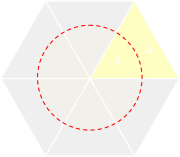Now let’s look at the length of the cut L. For this we can use the cosine rule for triangles.

Substituting in for b, we can get a formula for the length L, in terms of a:

If we differtiate this, and set this to zero, we can find the turning point:

The real positive roots for this equation give the results:

This gives us the interesting result that a, b, and L are all the same value. We could probably have guessed at this result from symmetery, and what this means is the solution to the cake problem is to cut off a smaller equilateral triangle piece from the corner of the cake.
Result
| |The length of the cut, L, to make this triangle is 1/√2 ≈ 0.7071 (cf. 0.8660 when we bisect the corner).We’ve used calculus to find the shortest straight line cut.|
|The length of the cut, L, to make this triangle is 1/√2 ≈ 0.7071 (cf. 0.8660 when we bisect the corner).We’ve used calculus to find the shortest straight line cut.|
We’ve used calculus to find the shortest straight line cut.
What if we remove the restriction that the cut needs to be a straight line? If we are allowed to make our cut curved, is it possible to reduce the length of the cut? The answer is yes. Here is the proof, and the calculation:
| |The first key to the proof is remembering that six equilateral triangles tesselate perfectly to form a regular hexagon.The second is the understanding that a circle is the most efficient container of area (This is the Isoperimetric Theorem): Among all planar shapes with the same area the circle has the shortest perimeter (or inversely: Among all planar shapes with the same perimeter the circle has the largest area). |
|The first key to the proof is remembering that six equilateral triangles tesselate perfectly to form a regular hexagon.The second is the understanding that a circle is the most efficient container of area (This is the Isoperimetric Theorem): Among all planar shapes with the same area the circle has the shortest perimeter (or inversely: Among all planar shapes with the same perimeter the circle has the largest area). |
The second is the understanding that a circle is the most efficient container of area (This is the Isoperimetric Theorem): Among all planar shapes with the same area the circle has the shortest perimeter (or inversely: Among all planar shapes with the same perimeter the circle has the largest area).
|If we imagined placing six triangular cakes together we could then carve a circle out of the middle.From the Isoperimetric Theorem, we know the circumference of this circle will be the smallest to enclose his area inside it.| |
|
From the Isoperimetric Theorem, we know the circumference of this circle will be the smallest to enclose his area inside it.
What we need to do is determine the radius of the circle such that one sixth of the it’s area is half of the area of the triangle.

The circumference of a circle is 2πr, and the length of the arc cut is one sixth of this.

Result
Not only is this circular arc shorter than the straight line, we’ve shown that this arc is the shortest possible of any kind of curve.
Even Shapes
Studying this is a little further, it’s possible to show that, for shapes with an ‘even’ radial symmetery (such as squares, rectangles, circles …) the shortest curve to bisect a shape is a straight line that passes through the cetroid. For ‘even’ radial symmetery, any radius r, and any angle θ, (measured from the centroid) are the same, such that r(θ)=r(θ+π).
Any straight line passing through the centroid of an ‘even’ shape bisects that shape.

 |
This interesting result allows us to easily solve puzzles that, otherwise, seem quite complicated. Imagine that you have a tray of delicious brownies and want to divide it equally in half. Unfortunately, some evil person has cut out a smaller rectangle of brownies from the middle at some obscure angle. What is the easiest way to make the cut? |
| The solution is to draw a straight line between the centroids of the two rectangles and make the cut along this line. From above, we know that a line passing through the centroid of an even shape bisects this shape. A line through both centroids bisects both shapes (both the cookie and the hole). Because of this, there will be the same amount of cookie on each side of the line. |  |
Shortly after publishing my article, I was contacted by Scott Carr, a talented graduate student from Rice University. Scott extended my simple equilateral triangle cake puzzle and solved it for a generic triangle. He sent me a link to his work, and then graciously offered to write it up for me to publish on this blog. You can view his article here.
You can find a complete list of all the articles here. Click here to receive email alerts on new articles.
Click here to receive email alerts on new articles.